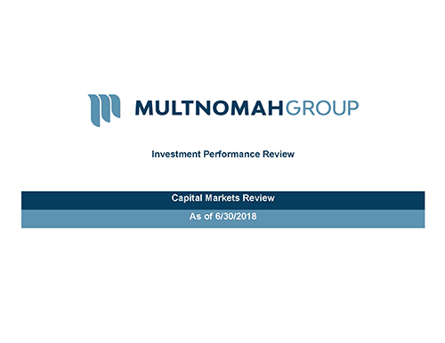 A strong U.S. economy gave the Federal Reserve confidence to raise interest rates again in June to a new target range for the fed funds rate of 1.75% to 2.00%. This is the seventh rate hike since December 2015. The U.S. economic expansion is in its ninth year, the second longest on record. Real GDP grew at an annual rate of 2.0% in the first quarter of 2018 (the most recent data available). GDP was weighed down by weak performance in consumer spending for the first two months of the year. Consumer spending, which makes up over two-thirds of the economy, has reported mixed results thus far in 2018. Inflation remains low. Core CPI, which strips out food and energy prices, rose marginally in May (most recent), up 2.2% versus a year ago. After falling to 3.8% in May, the U.S. unemployment rate rose to 4% in June as potential workers came off the sidelines. The U.S. is now experiencing a labor shortage and economists expect wage pressures to continue to build. U.S. manufacturing activity jumped in May and June in part because manufacturers were scrambling to move goods ahead of threatened tariffs.
A strong U.S. economy gave the Federal Reserve confidence to raise interest rates again in June to a new target range for the fed funds rate of 1.75% to 2.00%. This is the seventh rate hike since December 2015. The U.S. economic expansion is in its ninth year, the second longest on record. Real GDP grew at an annual rate of 2.0% in the first quarter of 2018 (the most recent data available). GDP was weighed down by weak performance in consumer spending for the first two months of the year. Consumer spending, which makes up over two-thirds of the economy, has reported mixed results thus far in 2018. Inflation remains low. Core CPI, which strips out food and energy prices, rose marginally in May (most recent), up 2.2% versus a year ago. After falling to 3.8% in May, the U.S. unemployment rate rose to 4% in June as potential workers came off the sidelines. The U.S. is now experiencing a labor shortage and economists expect wage pressures to continue to build. U.S. manufacturing activity jumped in May and June in part because manufacturers were scrambling to move goods ahead of threatened tariffs.
The yield curve continued to flatten during the quarter. The spread between the 2-year and 10-year Treasury narrowed further to 33 basis points at the end of the quarter. This spread is the tightest since the period of 2005 to 2007 prior to the Great Financial Crisis. Most points along the U.S. Treasury yield curve increased during the quarter, with the 2-year rising by 25 basis points to 2.52%, the 10-year increasing by 11 basis points to 2.85%, and the 30-year increasing by 1 basis point to 2.98%.
Fixed income was broadly lower throughout the quarter. The top fixed income performers were high yield bonds and TIPs, increasing 1.1% and 0.8% respectively. Developed international bonds and emerging markets bonds were the worst fixed income performers declining 5.0% and 3.5%, respectively.
U.S. equity markets bounced back in the quarter with the S&P 500 gaining 3.4%. Of the 11 sectors, seven ended higher. Energy, consumer discretionary, and technology sectors showed the largest gains during the period. Energy had its best quarter since 2011. Financials and industrials recorded the largest declines. The forward P/E for the S&P 500 dropped to 16.1x, now matching the 25-year average. Small cap stocks continued to outperform their large cap counterparts. Small value stocks beat small growth while large growth beat large value. The CBOE Volatility Index moderated in the second quarter after a huge spike upward earlier in the year, but the index remained at an elevated level with large gyrations.
International equities struggled with emerging markets being hit the hardest. The dollar rallied against most currencies during the quarter, particularly impacting international equity returns. The recent weakness in the euro this quarter (down 5.1% versus the U.S. dollar) has not benefitted European equities. Emerging markets reported the worst quarterly equity returns versus other asset classes declining nearly 8% in U.S. dollar terms versus a decline of 3.4% in local currencies. Additionally, Developed Europe (ex-UK) and Developed Asia had modestly negative equity returns in U.S. dollars. The UK market improved 3.0% in U.S. dollars versus being up 9.4% in local currencies given the weak British pound.
Oil prices were the bright spot of commodities in the second quarter despite the Bloomberg Commodity Index being basically flat for the period. U.S. crude oil prices jumped 14% to $74 per barrel. Gold prices declined 5.2% for the 3-month period finishing the quarter at $1,255 per troy ounce. REITs rebounded strongly (by 8.5%) during the period recovering all of first quarter’s losses.
To view Multnomah Group's full Capital Markets Review, please click here.
Multnomah Group is a registered investment adviser, registered with the Securities and Exchange Commission. Any information contained herein or on Multnomah Group’s website is provided for educational purposes only and does not intend to make an offer or solicitation for the sale or purchase of any specific securities, investments, or investment strategies. Investments involve risk and, unless otherwise stated, are not guaranteed. Multnomah Group does not provide legal or tax advice.
Any views expressed herein are those of the author(s) and not necessarily those of Multnomah Group or Multnomah Group’s clients.

